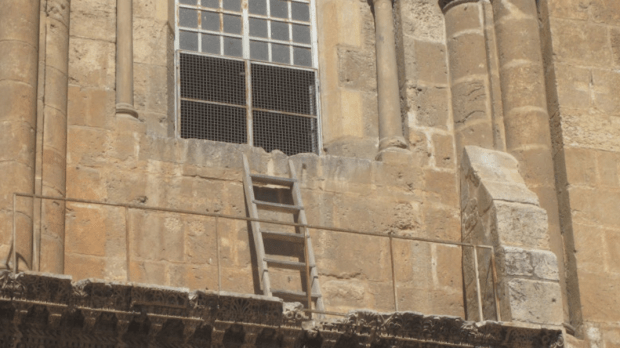Lenten Campaign 2025
This content is free of charge, as are all our articles.
Support us with a donation that is tax-deductible and enable us to continue to reach millions of readers.
An old wooden ladder rests on the ledge of the right window of the main facade of the Church of the Holy Sepulchre. They call it “the immovable ladder.” It has barely been moved from that ledge since 1757. Someone tried to steal it in 1981 (the person was immediately arrested by the Israeli police). Then, in 1997, someone managed to hide it for several weeks, but eventually the ladder was found and returned to its site. Finally, workers involved in the preservation and restoration of the bell tower of church had to move it in 2009 to set some scaffolding.
That aside, the ladder has just been there since the mid-18th century.
Like most churches in the Holy Land, the Church of the Holy Sepulchre is a place of worship of numerous and diverse Christian confessions. In the 18th century, during the reign of the Ottoman Sultan Osman III, the Status Quo Agreement was signed. In addition to dividing Jerusalem into quadrants, the Sultan also decreed that whoever was in control of a designated area in the city, would control it indefinitely in the future.
However, the agreement also included a special clause: if multiple groups had some authority over a certain site, they should all agree unanimously to any changes made to the site, however small. And while this decree proved useful in avoiding impositions of some groups on others, it has also made it impossible to properly maintain several of these pilgrimage sites: unless all parties entirely agree to the minimum detail, there is nothing that can be done.
This explains why the ladder has not moved since then. Currently, six Christian churches have rights over the Holy Sepulchre, and nobody is very clear about who owns that very particular ledge or the window on which the ladder rests. Even more, it is not clear who owns the ladder itself (although some claim it belongs to the Armenian Apostolic Church).
Clearly, over the centuries the ladder has grown to have an important meaning on its own. During his visit to the Holy Land in the mid-1960’s, Pope Paul VI understood how the ladder, a symbol of the Status Quo Agreement, had also become a sad testimony of the divisions among Christians. Considering the Roman Catholic Church is one of the six groups that must decide on changes to be made in the Holy Sepulchre, he decreed that the staircase would not be moved until the divisions between Christians were not resolved. In fact, a Muslim family has historically been entrusted with keeping the keys to the Church of the Holy Sepulchre. The keys keep getting handed down to the next generation.

